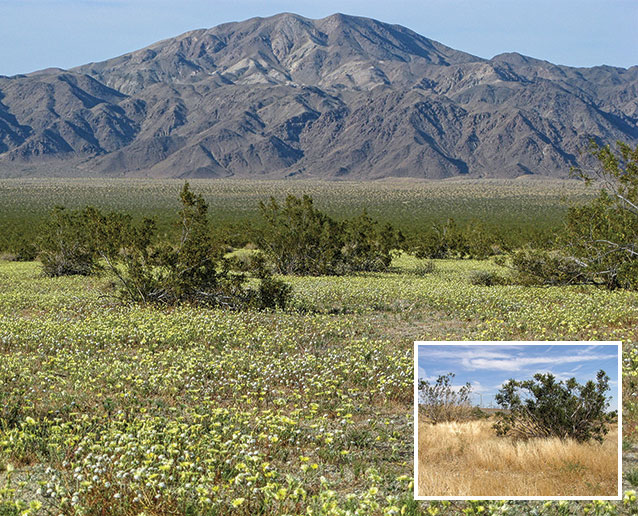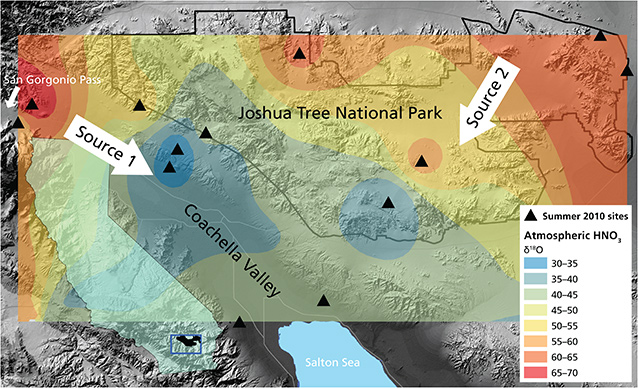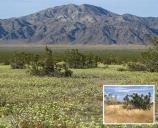As nitrogen deposition increases, the spaces between … shrubs increase in nutrient concentrations, which can lead to increased growth of invasive species.

Main: NPS Photo/Michael Bell; Inset: Edith B. Allen
Key words: air pollution, invasive plants, Joshua Tree National Park, nitrogen deposition, stable isotopes
DESERT SOIL NUTRIENTS are made up of various constituents and are not uniform in their spatial distribution in part because of perennial vegetation. Underneath desert shrubs, nutrients accumulate, moisture is greater because of shade and lower air temperatures, and organic matter is denser because of leaf fall and debris collection. In the shrublands of Joshua Tree National Park, California, creosote bushes (Larrea tridentata) act as “fertile islands” that provide nutrient-rich areas where annual plants flourish during the limited precipitation season. Unfortunately, the introduction of invasive annual plant species threatens the native annual plant diversity that is present following winter precipitation. The spread of these invasive species is being enhanced by anthropogenic, or human-related, sources of nitrogen (N) from air pollution deposits on Joshua Tree and threatens the ephemeral plant community that attracts visitors to the park each spring (fig. 1). As nitrogen deposition increases, the spaces between native shrubs increase in nutrient concentrations, which can lead to increased growth of invasive species. These changes in soil processes have the potential to influence overall desert plant communities by decreasing the richness of native plants and potentially leading to increased fires when invasive species get too dense.
Winds of change
Mobile emission sources within the sprawling urban landscape of southern California release a mix of nitric oxides (NOx) and ammonia (NH3) gases that travel on ocean breezes from the Los Angeles air basin eastward into the desert. As these molecules are carried with the wind, they may be deposited directly on the soil surface (dry deposition) or dissolved in moisture and enter the soil matrix with precipitation (wet deposition). As nitrogen accumulates in the soil it can increase the growth of vegetation, change the rate of microbial processes such as denitrification, and reduce the number of mycorrhizae (microscopic fungal communities that grow symbiotically with plant roots). The differential response of species to the changing conditions will affect the community composition of desert vegetation.
Atmospheric nitrogen deposition peaks in the park in summer (predominantly as dry deposition) because of increased sunlight and more air mass movement from the L.A. air basin (USEPA 2015). We measured the atmospheric concentration of N in Joshua Tree National Park and the adjacent Coachella Valley using passive air samplers at 13 sites in summer 2010 and winter 2011 to identify how anthropogenic N additions were contributing to soil N (Bell 2012). The Coachella Valley is the area of desert between the L.A. air basin and Joshua Tree National Park, and it is important as it provides an expansion of continuous creosote bush shrubland outside of the park boundaries. Data from summer N collections are presented here, as concentrations were significantly higher than in winter.

NPS/Michael Bell and Edith B. Allen
/Concentrations of both nitric acid (HNO3) and ammonia (NH3) peaked on the western end of the study area where air masses move through the San Gorgonio Pass and head down the valley to the park (NADP 2014). Using stable isotope analysis (see sidebar, page 67) of the nitrogen and oxygen (O) within HNO3, we determined that two different sources of nitrogen were having an impact on the national park (fig. 2). The main signal from the isotopes came from enriched O molecules within HNO3. Anthropogenic HNO3 molecules have an isotopic signature near 70‰ (Hastings et al. 2003) and mix with local, biogenic emissions, with an isotopic signature around 30‰ to create a gradient in isotopic signatures as nitrogen is deposited on the ground. Anthropogenic emissions are evident in two parts of the study area. The dominant source (“Source 1” on the map) of nitrogen, as expected, came from the west, where high concentrations of nitrogen come into the Coachella Valley from Los Angeles. The second source (“Source 2”) comes from the north end of the study area and dissipates south into the park. Although these are low concentration emissions, they are measurable because of low background N and are associated with emissions from vehicles around and inside the park.
Isotope analysis of soil samples at each site revealed that anthropogenic nitrogen was accumulating in the soil. Since most of the deposition comes down as dry deposition in summer, anthropogenic nitrogen accumulates in the upper 2 cm (0.8 in) of the soil profile, in the gaps of soil particles and soil crusts. With the first rains in winter, this accumulated nitrogen becomes bioavailable to germinating seedlings and increases the growth of annual vegetation. Understanding how soil processes are linked to atmospheric patterns can give managers an edge when dealing with the spread of an invasive plant species, as these plants often take advantage of increased resource availability.
Fire of life
To understand how increasing soil N affects annual vegetation growth, we completed a second study in the creosote bush scrubland of Joshua Tree National Park (Allen et al. 2009). This experiment artificially increased soil N to measure its effect on winter vegetation. Four NH3NO4 fertilizer treatments simulated the potential future effect of anthropogenic deposition. Within fertilized plots, both native and invasive annual species increased in cover. Native annual species have evolved in low-nutrient systems, so while the addition of N—the most limiting nutrient—led to greater growth, there was a differential response relative to the dramatic increase of the invasive species. Native species richness did not decline across the entire study area, but native cover did decline in each plot relative to the invasive common Mediterranean split grass (Schismus barbatus). The addition of nitrogen to the soil increased cover and standing biomass in the interspace areas, making these areas more similar to the undershrub habitats.
These growth responses—particularly the increase in invasive common Mediterranean split grass—were especially strong during high-precipitation years, such as 2004 when a pronounced El Niño event increased winter precipitation far above the average for the area. This is because water is the most limiting factor for plant growth in the desert. Generally, desert soils are very coarse and do not have much organic matter, limiting water retention. When water did not limit growth, however, the added nitrogen had a significant impact on the amount of the invasive grass that grew. Based on calculations of biomass accumulation, we determined that increasing deposition past a critical load of 4 kg/ha/yr (3.6 lb/ac/yr) could increase cover of invasive grasses to the point where fire can spread among shrubs (Rao et al. 2010). The space between shrubs usually prevents fires in the desert from spreading quickly or getting too large, but when shrubs are connected by a carpet of annual vegetation instead of ephemeral native species (see fig. 1), fire can easily move from shrub to shrub and burn through the landscape. This change from historical smaller fires has the potential to have lasting impacts on the desert landscape because perennial species are not adapted to this type of disturbance.
Future trends
Anthropogenic nutrient inputs to nutrient-limited ecosystems highlight the connectedness of the air-soil-plant continuum. Predictions for winter 2015–2016 are for above-average precipitation because of a strong El Niño Southern Oscillation building in the Pacific Ocean. If this occurs, it is likely that areas on the western edge of Joshua Tree National Park that are over the critical load of nitrogen for invasive plant growth may again experience above-average levels of biomass, which could cause fire to spread throughout the desert. While air quality has gotten better in southern California, even with continued population growth, the sensitive desert ecosystem is still at risk. Continued monitoring and modeling efforts by the National Atmospheric Deposition Program (NADP 2014) allow managers to keep track of the current deposition levels and increase their active management in high-risk areas.
References
Allen, E. B., L. E. Rao, R. J. Steers, A. Bytnerowitcz, and M. E. Fenn. 2009. Impacts of atmospheric nitrogen deposition on vegetation and soils in Joshua Tree National Park. Pages 78–100 in R. H. Webb, L. F. Fenstermaker, J. S. Heaton, D. L. Hughson, E. V. McDonald, and D. M. Miller, editors. The Mojave Desert: Ecosystem processes and sustainability. University of Nevada Press, Las Vegas, Nevada, USA.
Bell, M. D. 2012. Using stable isotopes of nitrogen and oxygen as environmental indicators of nitrogen deposition in the Sonoran Desert. Dissertation. University of California, Riverside, California, USA.
Hastings, M. G., D. M. Sigman, and F. Lipschultz. 2003. Isotopic evidence for source changes of nitrate in rain at Bermuda. Journal of Geophysical Research 108:4790.
NADP (National Atmospheric Deposition Program). 2014. Total Deposition Maps [2014.02]. Accessed 10 October 2015 from http://nadp.sws.uiuc.edu/committees/tdep/tdepmaps.
Rao, L. E., E. B. Allen, and T. Meixner. 2010. Risk-based determination of critical nitrogen deposition loads for fire spread in southern California deserts. Ecological Applications 20:1320–1335.
USEPA (U.S. Environmental Protection Agency). 2015. Clean Air Status and Trends Network, JOT403. Accessed 10 October 2015 from http://www.epa.gov/castnet/sites/jot403.html.
About the Authors
Michael D. Bell is an ecologist with the NPS Air Resources Division in Lakewood, Colorado. Edith B. Allen is a professor of plant ecology and a cooperative extension specialist with the Department of Botany and Plant Sciences at the University of California, Riverside.
Download: PDF of this article
This article published
Online: 6 May 2016; In print: 25 March 2016
URL
https://www.nps.gov/ParkScience/articles/parkscience32_2_64-66_bell_allen_3838.htm
Suggested citation
Bell, M. D., and E. B. Allen. 2016. Wind, earth, and fire: The impacts of anthropogenic air pollution on soils in Joshua Tree National Park. Park Science 32(2):64–66.
This page updated
5 May 2016
Site navigation
• Back to Volume 32, Number 2
• Back to Park Science home page
Last updated: August 9, 2018

